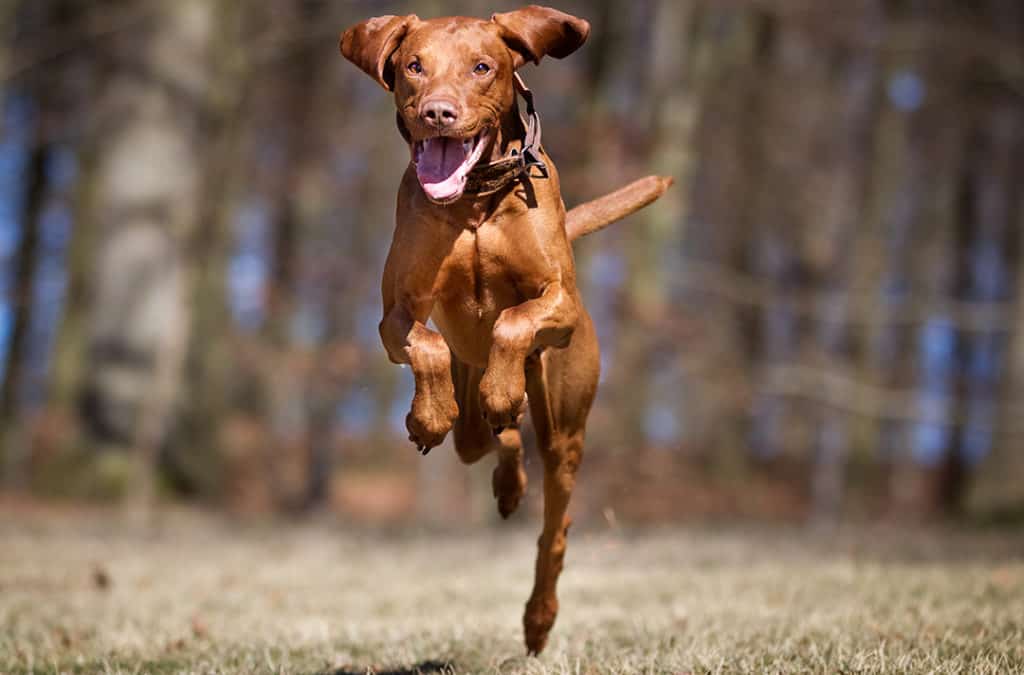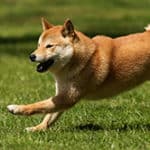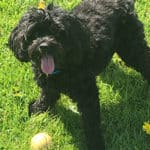
As a working dog with a long history of being used as such, the Vizsla is meant to be a very active dog. It is hard to deny this fact after meeting the breed even once. In this article, we will be discussing the general activity level of these dogs and giving you some valuable tips so that you can get your dog the exercise that they need in order to maintain peak health and happiness.
How much exercise does a Vizsla puppy need? As a guideline, use a minimum of 5 minutes for each month in age, up to twice per day or as needed. At 3 months it would be 15 minutes 2x per day, 6 months is 30 minutes 2x per day. Vizslas are an especially active breed, but as a puppy, they have limits and are developing. While they can play for hours, hard exercise is different. It is important to look for signs your puppy needs to be more active or has had enough and needs rest.
3 Months Old = 15 Minutes (Twice a day)
6 Months Old = 30 Minutes (Twice a day)
9 Months Old = 45 Minutes (Twice a day)
A fully grown Vizsla can go out much, much longer
| Perfect for Puppies | Too Much Stress |
| Walks around the block on leash, keeping it casual and fun. | Jogging or biking for any significant stretch might be too much for a smaller puppy. Don’t make them keep up with you, go at her pace. |
| Free play in the yard with some toys. Let them run and play and have fun with them! If things get too exciting try and calm them a bit. | Long stretches of running and really vigorous play at the puppy stage might be too much |
| Walking around the house is always fine for a pup, you can guide him or her along with you to get some exercise. | Climbing stairs, hills, or really long stretches of strenuous activity, you need to watch for signs they are ok. |
| A fun game of fetch or tug of war is a popular way to get in some exercise with puppies around the world! | Again watch for signs of too much. Puppies are still growing and developing. Too much can put strain on joints at this age. |
Three Levels Of Activity
There are basically three levels of dog activity. No, this isn’t an official thing, but rather a convenient method of classification specific to this article. It will be up to you to decide which level your dog requires at a given time.
Remember that as a puppy, most breeds, Vizsla included, get bursts of energy. They will want to zip around and run, fast, now! Followed by a nap or snuggling up in your lap. So be aware that they are still little, and can’t keep a frenetic pace for a long time.
Light
The first level could be described as “light activity.” The most common example of this kind of exercise would be a simple walk. We’re talking about a standard dog walk here, around the block or down the street. Long walks or particularly fast walks belong in the second category. Another example of a light activity would be an afternoon game of fetch in the yard. Having been used as a retriever breed for many centuries, Vizslas love to play fetch, and you will probably get tired of this game long before they do.
Moderate
The second level of activity might be described as “medium activity.” examples of this would include a light jog with your dog running beside you, or maybe a little rough play. Many dogs enjoy wrestling and rough-housing with their owners, and most will be able to play-fight without causing any harm. The Vizsla doesn’t do this as often as some other breeds, but they will certainly wrestle with you if they are encouraged to do so.
High
The third level would be described as “intense activity.” This is the high-level exercise that really pushes your dog to the limit. Obviously, you don’t want to do this too often. A dog’s heart is much smaller than our own, and they cannot always maintain strenuous activity for as long as we can. Good examples of this activity type would include a fast run, a trip through the agility course, or some obstacle jumping.
When working with a dog that hasn’t done this kind of thing in the past, it is best to work them into the process incrementally. Don’t start your dog at level three, or you will have a much higher risk of injury to the animal. Always begin at level one and gradually work the dog up the scale. Remember: this isn’t a “Rocky” film. You aren’t trying to push your dog to the limit.
At what age can a Vizsla start running or being more active?
Like most dogs, a Vizsla will become active almost immediately after being weaned. Once their legs become strong enough for running, they will do it on their own with no need for any help from you. When you see them doing it on their own, they are old enough. The rule of thumb here is to refrain from making your dog engage in serious exercise until they show readiness. For most pups, this will happen at 5-6 weeks.
At this age, their activity level will still be relatively low compared to that which you will see at adulthood. At 10-12 weeks a puppy should be fully active, running around and playing with other pups in the litter. At this point, it’s actually a good sign if the pup gets into a little bit of mischief, as it will confirm that the dog possesses the intelligent and inquisitive nature that is so common for this breed (source).
Important Indicators
This dog can deal with overheating a little more easily than other breeds, due to their thin coat. However, there are several signs that you need to look for when exercising your dog. If you see any of these signs, it means that your dog needs a rest (source):
- Big increase in panting
- Excessive drooling
- Dogs’ forehead feels hot to the touch
- Rapid heart rate
- Vomiting (extreme cases of exhaustion only)
- Weakness of the legs causing “wobble”
As for signs that your dog needs exercise, you might find they are bored, chewing on things excessively and hyper. Another would be carrying a toy to you and whining. All signs they want to go out and play! This is a lean-bodied dog, so anytime they become even leaner, it is cause for concern. They may need exercise, or they may require worming. A fat dog is obviously a dog that needs more exercise, but it would be a rare sight indeed to see a heavy Vizsla pup or young adult.
If you are working with a dog that is seriously overweight, you should first take them to the vet. You want to verify two things: First, verify that the dog’s obesity isn’t caused by some underlying health condition. Glandular issues and many other conditions can cause a dog to gain weight. Second, you will need to verify that the dog is healthy enough for an exercise program. What would you rather have, a fat dog or a dead dog? When we look at the question in this way, it is obviously better to be cautious and refrain from pushing your dog more than necessary.
Mental Stimulation
This goes along well with physical exercise as you want to make sure your Vizsla gets both. When you are playing and interacting with them as a puppy, this will go a long way to getting them socialized and stimulated. Playing with their ears, muzzle and paws for example.
A game of fetch or a little tug of war will be good stimulation as well. You can also introduce toys, and simple puzzle games are available for puppies. A classic Kong toy filled with some food is a good way for them to interact and work at solving something.
Simple training like “Sit” and “Stay” will exercise their young minds too. Remember Vizslas can be a little on the immature side as a puppy so patience and repetition are the keys here.
How Much Exercise Does An Adult Vizsla Need?
A Vizsla requires a high level of exercise. 45-60 Minutes of vigorous exercise per day at a minimum is recommended. Running with you, swimming, hiking or biking as examples. Lively and long games of fetch, tug of war, or hide and seek.
Indoors on a rainy day you can use stairs to go up and down if needed, or the same games of hide and seek. Obedience training here is a good form of exercise in that they are being asked to do physical things and exerting mental energy to recall how to do it. Of course Vizslas are not shy about being out in a bit of rain for the most part.
In ancient times, this dog would follow the nomadic Magyar peoples, helping them to herd their animals and hunt their food. Back then, the dog had to keep up with a constantly-moving tribe of people, and if they could not do so, they were usually left behind. Although the ancient breed was probably a little feistier, the modern Vizsla is still an active working dog.
These dogs have such a high intelligence level, combined with a high energy level, that they can easily get themselves into trouble if you don’t give them something to do. A dog that has been exercised thoroughly will probably be a lot less likely to destroy your house when left alone. When you add the breed’s propensity for separation anxiety into the mix, you get a dog that really needs to be kept occupied.
Related Questions
What are some options to get my dog some more exercise on days I am not around?
Yes, there are several options. One of these options is doggy daycare. On the upside, this kind of service will ensure that your dog gets all the exercise they need. By giving them someone to play with, you will allow them to stay in shape and have fun at the same time. Just be careful to only leave your dog with someone you trust. If your dog seems to be scared of their dog-sitter, it’s a big red flag. You can also hire someone to walk your dog without actually dogsitting them. This isn’t a bad option for those who work a lot and need someone to take care of this minor task. You might also consider buying a dog treadmill.
Do Vizslas like to swim?
Yes. Like the Labradors that they somewhat resemble, the Vizsla is a water dog. They even have webbed feet, although you have to look somewhat close to see them. These dogs tend to be strong swimmers and should have relatively little risk of drowning. This Vizsla owner was good enough to provide us with a dogs’-eye view of the way that they swim.
Conclusion
Like any pup, a Vizsla needs to get plenty of exercise. Not only is this essential for maintaining the proper health of the dog, but it also helps to let them work out some of that excess energy so that they will be easier to manage when you bring them in the house. These dogs need a lot of attention, but in the absence of that, they need to be allowed to indulge their active nature. We hope that you and your dog can have a lot of fun together, keeping your Vizsla healthy and happy well into old age.




